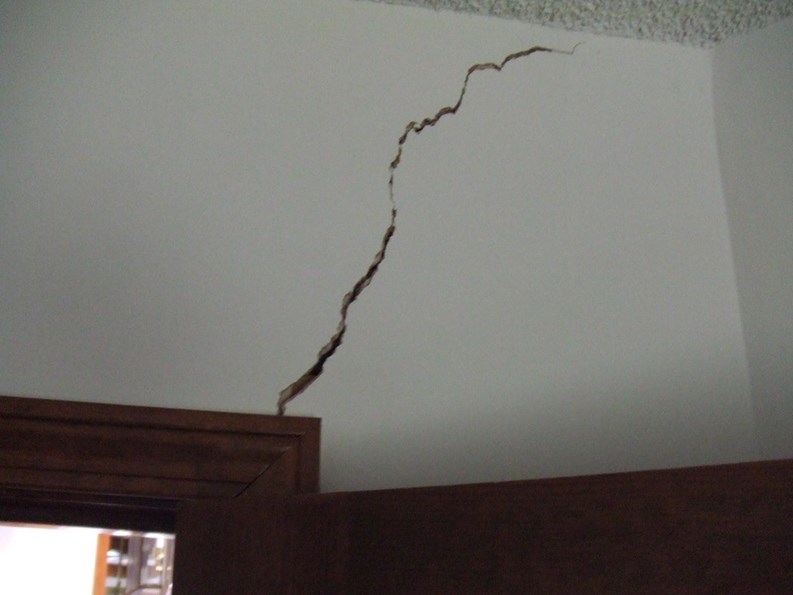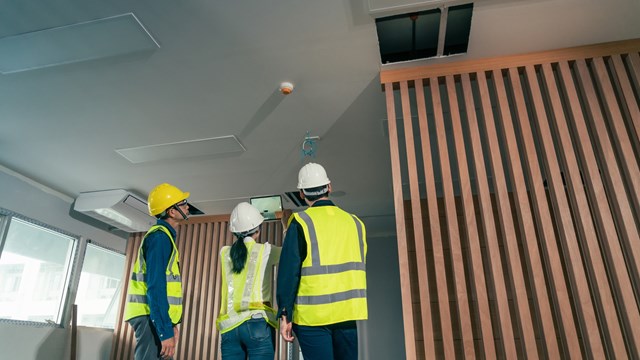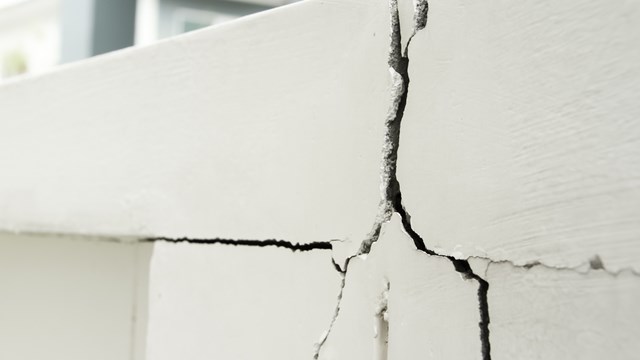Many people believe in the ethos of 'reduce, reuse, and recycle'—they buy vintage clothing, pre-owned cars, or refurbished electronic equipment. But most of us also like brand new things, including homes. And with markets across the country rebounding from the economic meltdown of the recession, new homes are becoming an option for more people and the lure of Wi-Fi, designer name appliances and other state-of- the-art finishes can’t be ignored.
Living in shiny, fresh-out-of-the-box construction sometimes comes with problems, however; leaks in condo units, mechanical problems, insufficient noiseproofing, and other issues, may crop up. While it might be better if every buyer could purchase a 2-year-old, already lived-in condo with the creaks worked out, real estate is often about timing as much as it is about location—so you buy when you can and when the market is right. If you’re buying new, it pays to take what steps you can to insure that the unit you're purchasing is as close to perfect as it can be. Caveat emptor isn’t just an adage to remind buyers to be careful. When the thing you’re buying is also where you’ll be living and likely represents your single biggest investment, naturally you want to protect that investment by every possible means. Ensuring your new home is in top shape before you move in is a good place to start.
Finding Trouble-Spots
When it comes to construction defects in new buildings, it’s not usually the building designer’s fault, says David Colston, PE, owner of Structural Engineering Associates Inc., in West Palm Beach. “Most of it is improper installation,” he says.
One of the most common examples of this is stucco problems. Cracked and crumbling stucco on the exterior of your building—particularly if the structure is relatively new—is more than just an annoyance and an aesthetic problem; it also may be an indication that the stucco was incorrectly applied, or that improper materials were used in the job. Both can be a major problem, because aside from contributing to the look of a property, stucco forms part of a building's waterproofing system.
When badly executed, that causes major problems with water infiltration, as it did for a condo that filed a sizable claim for improperly applied stucco on its building, says Ryan Owen, a partner with the law firm of Adams & Reese, LLP in Sarasota. In that case, the subcontractor didn’t use the right materials to ensure that the stucco adhered. A few years after the work was done the stucco was falling off of the building and had to be completely repaired.
And imperfect stucco is just one aspect of compromised waterproofing that can haunt a multifamily building. Other details such as expansion joints, sealants and flashing can also morph into expensive repair emergencies if installed poorly or left uncompleted; new windows and sliding glass doors can also leak water if weather stripping is missing or improperly fitted. This is especially crucial in a hurricane-prone area such as South Florida. Poor installation of sliding glass doors can lead to deterioration between the gasket and actual glass, says Nicholas Siegfried, an associate attorney working in construction law for the Coral Gables-based law firm of Siegfried Rivera Hyman Lerner De La Torre Mars & Sobel, P.A. “It affects the look of the door, and its air-tightness,” he says.
According to Colston, the devil's in the details; something as small as the fasteners used to attach a sliding glass door frame to the building can cause much bigger problems if they're not installed according to the manufacturer’s specifications. If they aren't, the entire window or door system is not as strong as it was designed to be, and less able to handle high winds and rain. If one or more of the windows or doors are weakened in this way, it compromises the building envelope and can lead to greater and possibly unsustainable pressures on windows during a tropical storm or hurricane. That could lead to a window blowout and a whole lot of other problems after that, like water damage and mold.
Another potentially costly problem Siegfried has seen concerns post-tension cables, a common element of larger multifamily condo developments. Post-tension cables are stressed at their ends, and they have caps covering those ends. The caps can be incorrectly installed, such as not fitting because the wrong size cap is used, or they can become damaged or cracked. If caps don’t fit correctly or are cracked, the elements can get in and rust the steel. Even if the building doesn’t have stucco and concrete corrosion problems (evidencing an obvious water infiltration problem), a professional still needs to inspect and look for the post-tension cable problem.
“They need to dig into that post-tension pocket and see what’s up," Siegfried says. "It could be a significant cost to repair, down the line." How big a cost? Potentially, it could be millions of dollars to fix.
And worst of all, many of these types of defects aren’t immediately apparent during an open house or walk-through. “Sometimes you don’t know there’s a problem with a sliding glass door or window until they don’t work,” says Steven Mainardi, PE, RS, principal founder and president of Delta Engineering & Inspection, Inc. in Sarasota. And the aforementioned post-tension cable problems are all but invisible to anyone except a trained engineer who knows what to look for.
Recalling a Golden Age
Problems like the ones mentioned above weren’t always such a concern for residents of Florida multifamily buildings. Generations ago, housing stock was built much more solidly. At least, that’s the conventional wisdom. “They always say, ‘They don’t build them the way they used to,'" says Mainardi, "and I always say, ‘Thank God.' The design requirements today are much stricter. But the workmanship today is not as good as it was.”
It’s true that structurally speaking and in terms of safety, codes for building construction are far tougher than they were decades ago. Even so, in Florida many consider the Golden Age of residential construction to be the stylish Art Deco era of the 1920s and 1930s. The more traditional architectural styles of the prewar era also are known for exceptional construction—though again, safety standards weren’t as rigid as they are today.
According to the pros, part of the disconnect that results in construction defects these days isn’t simply contractors rushing through jobs, or workers not knowing what they are doing, or not caring enough to do it right in every instance. There’s simply not enough management. "The critical issue is the poor oversight," Mainardi says. "We don’t have many people watching the workforce, and the quality control is not there.”
Clearly, the workmanship on some projects isn’t what it once was, based partly on the fact that better materials and techniques cost more. Skilled workers also cost more, and when a developer is trying to build a place as fast as possible, some things might be left out.
Another factor contributing to hurried construction is the law, says Owen. The Interstate Land Sales Full Disclosure Act of 1968 is a federal law applied to projects that required land developers to register subdivisions of more than 99 lots or condominium units. Under the law, the developer is incentivized to finish the project in less than two years. If the project takes more than two years to finish, under the ILSA all the buyers in the project have the option to cancel their contract if the development hasn’t been federally registered. And registration will cost the developer a hefty fee.
“There’s a lot of construction going up in Miami; contractors might want to get the job done faster, and sometimes they cut corners,” Siegfried says. “There’s always going to be some issue [with construction], but is the developer responsive, and willing to fix the issues? Some developers really care about their reputation.”
Doing Your Homework
Whether you attribute it to the shortage of skilled labor, or developers rushing projects, or subcontractors and their employees not caring enough about their work, one thing is certain: in the end, it’s often the association and/or the individual unit owners who have to deal with construction problems in their building, and frequently associations and individuals seek to redress their grievances with developers and their contractors. All may be held liable if the unit owner or association decide to sue. In such cases, lawyers often sue the insurance companies that insure these professionals, and also sue the developer’s insurer. But these proceedings are long, expensive, and can be acrimonious. Who needs the hassle if you can avoid it?
A would-be buyer into a condo community naturally should do some research to ensure that they are making a wise investment in a financially solid community. In addition to looking at the meeting records of the board of the association (if possible), they should also look into the developer’s reputation and portfolio. Check on the firm’s other projects. If the developer of a building they are considering buying into has longstanding legal problems over earlier projects, it’s wise to investigate a bit further before signing on the dotted line.
If the developer still holds units for sale and the turnover of the building to the association hasn’t occurred, the association could file a Chapter 558 turnover report. It provides for an inspection period and time for the developer to respond to the claim before it becomes a lawsuit. Under the statute, a community association with more than 20 units must send by certified mail a written notice (a.k.a. “Notice of Claim”) on the potentially responsible parties at least 120 days before filing a lawsuit. Any prospective buyer may request a copy of this report.
On the physical side of the equation, a buyer checking out a potential next home should of course look for water stains around the edges of the windows and doors. If the apartment is drafty, or it’s loud with noises from outside seeping in, that could mean that it's not well-insulated, or that soundproofing is lacking. But as stressed above, many construction problems aren’t apparent to the unschooled eye, which is why a condition assessment of the building should be done by a trained professional engineer.
“It’s the things that aren’t obvious that will surface down the road,” Mainardi says. “The engineer looks into how a window was installed. Or they might see how the roof was attached, or go into an attic to see if fasteners were installed.” In checking out the building, the engineer will also be able to determine “normal” cracking in the place, as opposed to structural cracking. And he would inspect all of the building’s systems, Mainardi says.
When the developer turns over the building to the association, the firm must provide the association with an engineering report on the state of the building. “Generally, the condo hires its own engineer, to compare the report with his own inspection and report,” Owen says. After that, the association’s attorney and the developer’s attorney will get together and agree on the needed repairs.
Because of the specialized nature of such negotiations, the association should hire a lawyer with experience in that area of the law. “Hire a lawyer with experience in turnovers,” Owen says.
Florida state law provides statutory warranties of 1 to 3 years on some parts of a newly constructed building, and the contractor and subcontractors should also warranty their work. If the construction defect affects the entire building, the association can sue on behalf of all the owners to get compensation for repairs. The association also might have a claim to pursue if there’s a building code violation involved, or if the developer promised amenities that it didn’t deliver on, like a Pilates room, wine cellar, or a second pool.
Whenever the ribbon is cut on a brand-new condo or HOA, the excitement and luxury of all-new features and amenities is palpable—but it's often cut with some disappointment over the things that weren't done quite right, or weren't done at all. By hiring professionals to look over your new abode and advise both you and your board about any issues they find, you'll be in a much better position to make decisions, either about moving in, or about how your community can move forward and remedy some of these more common construction defects before they cost you and your new homeowners.
Jonathan Barnes is a freelance writer and a regular contributor to the South Florida Cooperator.







Leave a Comment